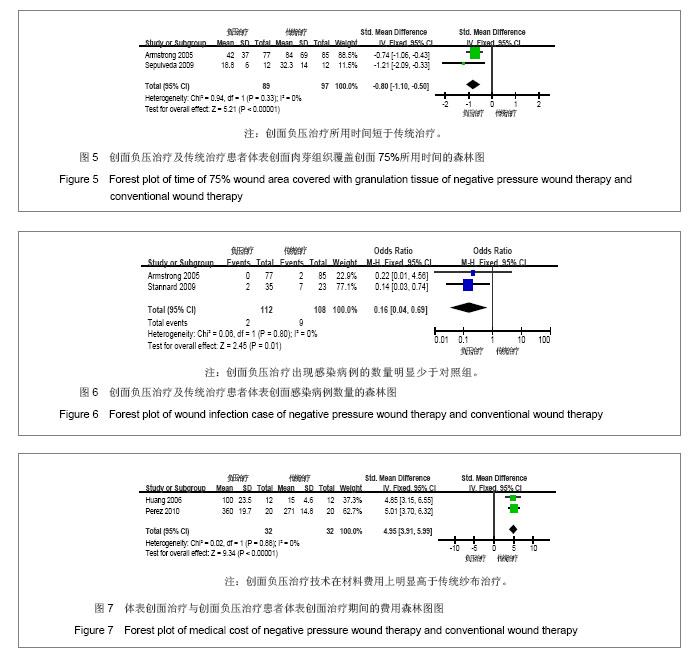2.1 文献检索结果 共检获1 756篇,初检447篇,经过阅读题录后排除明显无关文献267篇,余180篇。再阅读文章摘要排除回顾性对照研究、综述等研究158篇,余22篇文献查找全文。阅读全文排除不符合纳入标准的文献7篇
[1-7]。
最终15个研究符合纳入标准被保留。各个试验研究报告的结果不尽相同。文献均以英文形式发表,各个研究患者数量6-169例。随访时间为15 d至12个月。结局指标包括:完全愈合的时间、伤口表面的变化、试验期间内感染伤口愈合的比例、移植皮片成活率、术前准备时间、感染率、疼痛、生活质量、水肿、不良事件、住院时间、费用、细菌量。
2.2 文献筛选流程 见图1。
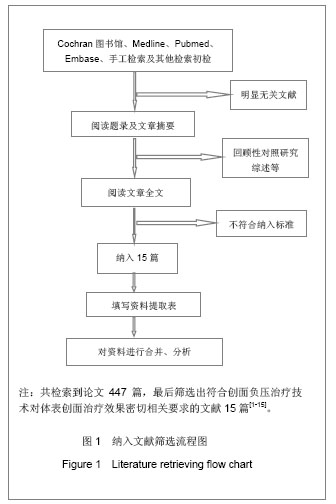 2.3 纳入研究的一般情况
2.3 纳入研究的一般情况 统一设计临床资料提取表,填写15篇文献内容,见表1。
2.4 纳入研究的方法学质量评价 按照Cochrane协作网提供的系统评价员手册要求(5.0.0 版)的7条标准进行偏倚风险评估。共有5篇文献为C级,具有高度偏倚风险;10篇文献为B级,具有中度偏倚风险,见表2。
2.5 对不同类型创面疗效的评价 各个临床试验对所得出的结果不尽相同,可以分为:时间类指标(如达到某个效果的所用的时间)、数量类指标(如到达观察点后创面的各种变化)、事件类指标(截肢例数、愈合例数、疼痛强度等)。
2.6 创面负压治疗技术对慢性创面的疗效 本组比较纳入10篇文献,各对照组采取的干预措施相同但结果判定指标不完全相同,按照不同的结果判定指标分类做以下分析。
2.6.1 创面完全愈合所用的时间 3个研究报告了该指标,在Braakenburg 等[7]的随机对照试验中,32例患者采用创面负压治疗技术治疗,对照组33例采用藻酸盐敷料、水胶体、水凝胶以及泡沫敷料,其报告到达创面愈合的时间治疗组为10.2 d(SD 47),n=32;对照组为 16.8 d(SD 65.2),n=33。
Mody等[12]的小样本随机对照试验中15例患者采用创面负压治疗技术治疗,对照组30例也采用的藻酸盐敷料、水胶体、水凝胶以及泡沫敷料,其报告的愈合时间治疗组为35.9 d(SD44.5),n=15,对照组为42 d(SD 46.7),n=30。
McCallon等[1]报告10例小样本的随机对照临床试验中,5例试验组患者接受创面负压治疗技术治疗,5 例对照组患者采用藻酸盐敷料治疗。创面负压治疗技术组平均愈合时间为22.8 d(SD 17.40),对照组平均时间为42.8 d(SD 32.5)。
合并效应量的检验Z值和P值为:Z=0.89,P=0.38,差异没有显著性意义,说明2种治疗方式下创面愈合所用的时间相同。见图2。
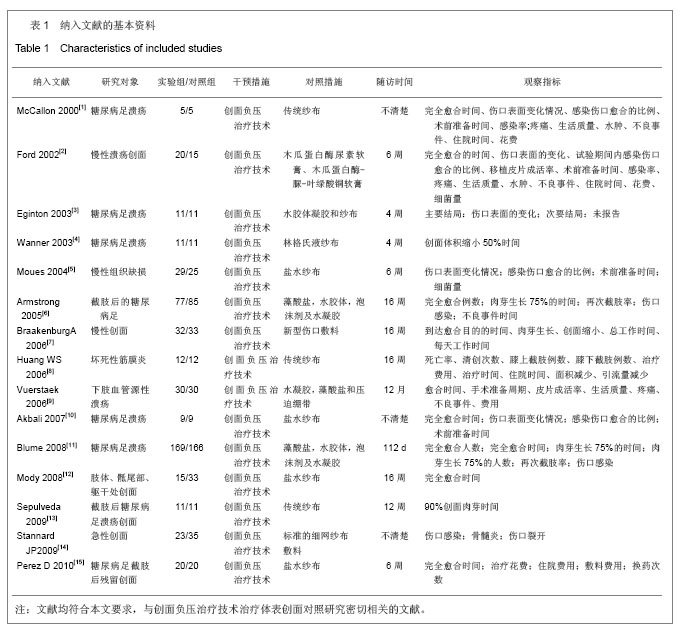
2.6.2 创面缩小50%所需时间 一个研究Wanner等
[4]报道了该指标,采用固定效应模型分析,创面负压治疗技术组平均为27 d(SD=10),
n=11,对照组平均为
28 d(SD=7),
n=11,均数差(MD)的效应量为-1.00,均数差95%可信区间为[-8.21, 6.21],
P=0.79,两者比较,差异无显著性意义,说明当创面面积缩小为50%的时候创面负压治疗技术和传统治疗所用的时间没有差别。
2.6.3 创面75%覆盖肉芽时间 一个研究Blume等[11]报道了该指标,采用固定效应模型分析,创面负压治疗技术组平均为58 d(SD=44),n=169,对照组平均为 84 d(SD=62),n=166,均数差(MD)的效应量为-26.00,均数差(MD)95%可信区间为[-37.53,-14.47],P < 0.01,差异有显著性意义,说明在当创面75%被肉芽组织覆盖时,创面负压治疗技术组所用的时间明显少于对照组。
2.6.4 创面达到可以手术的条件所用的时间(术前准备时间) Blume等[11]报道了该指标,创面负压治疗技术组平均为56 d(SD=42),n=169,对照组平均为144 d (SD=70),n=166。
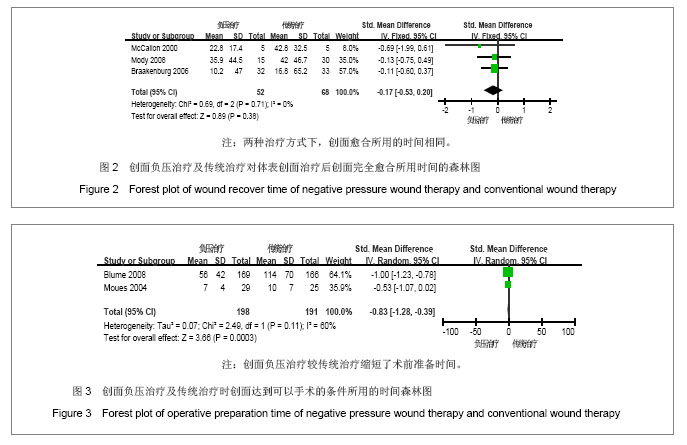
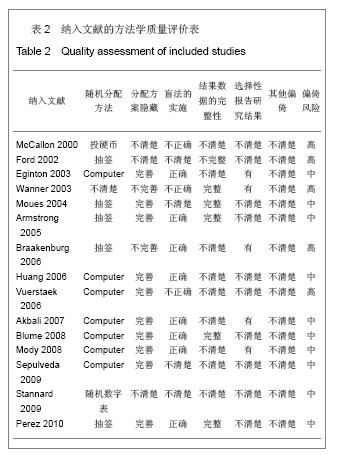
在Moues等
[5]的一项小样本随机对照临床试验中,29例试验组患者采用创面负压治疗技术治疗,25例对照组患者采用传统纱布换药治疗。负压治疗组患者平均 7 d(SD=4)可以满足进行手术干预,对照组为平均
10 d(SD=4)。
合并效应量的检验Z值和P值为:Z=3.66,P= 0.000 3,差异有显著性意义,说明创面负压治疗技术组明显比传统治疗缩短了术前准备时间。见图3。
2.6.5 创面完全愈合的病例数 在1篇Ford等[2]的一项小样本随机对照临床试验中,20例试验组患者采用创面负压治疗技术治疗,15例对照组患者采用创面外敷木瓜蛋白酶尿素软膏。试验经过6周观察,治疗结束后,负压治疗组患者有2例创面完全愈合,对照组同样有2例患者创面完全愈合,比值比(OR)=0.72,95%CI为[0.09,5.81],P=0.76,差异无显著性意义,说明到达6周时两种治疗方式愈合的数量没有差别。
2.6.6 创面面积的变化情况 3个研究报道了这一指标,它们均报告了单位时间创面面积缩小的比例。均数差(MD)的合并效应量为9.13;均数差(MD)的合并效应量的95%可信区间为[2.87,15.38];合并效应量的检验
Z值和
P值为:
Z=2.86,
P=0.004,差异有显著性意义。见图4。
2.6.7 截肢事件 在1篇Blume等[11]的随机对照临床试验中,169 例患者采用创面负压治疗技术,166例对照组患者采用传统治疗方法。治疗结束后,创面负压治疗患者有7例被迫截肢,对照组被截肢为17例,比值比(OR)=0.38,95% 可信区间为[0.15,0.94],P=0.04说明创面负压治疗技术组截肢率明显小于对照组。

2.6.8 疼痛强度得分 在Vuerstaek等
[9]6的一项小样本随机对照临床试验中,30例试验组患者采用负压治疗,30例对照组患者采用藻酸盐及水凝胶换药治疗。负压治疗组患者疼痛平均得分0.2(SD=0.7),对照组得分平均0.4(SD=0.6),均数差MD=-0.20,95%
CI为[-0.53,0.13],
P=0.23,差异无显著性意义,说明两种治疗方式在疼痛强度上没有区别。
2.6.9 并发症数量 在Vuerstaek等[9]的一项小样本随机对照临床试验中,30例试验组患者采用负压治疗,30例对照组患者采用藻酸盐及水凝胶换药治疗。负压治疗组12例出现并发症,对照组出现7例,MD=2.19,95% CI为[0.72,6.70],P=0.17,差异没有显著性意义。说明两种治疗方式在并发症数量上没有区别。
2.7 负压吸引对急性创面的疗效 本组比较纳入5篇文献,由于每个试验所使用的干预措施不同,按照不同的结果指标分类做以下分析。
2.7.1 术前准备时间 在Perez 2010的一项小样本随机对照临床试验中,20例试验组患者采用创面负压治疗技术,20例对照组患者采用传统纱布换药治疗。创面负压治疗技术组患者平均16.3 d(SD=9.7)可以满足进行手术干预,对照组为平均25 d(SD=15.5),MD=-9.10,95% CI为[-17.11,-1.09],P=0.03,差异有显著性意义。说明应用创面负压治疗技术在术前准备时间上明显短于传统纱布治疗。
2.7.2 肉芽组织覆盖创面75%所用的时间 2个研究报告了该指标,Armstrong等[6]的小样本随机对照试验中,77例患者采用创面负压治疗技术治疗,对照组85例采用藻酸盐敷料、水胶体、水凝胶以及泡沫敷料,其报告创面75%有肉芽组织生长的时间在治疗组为平均为 42 d(SD=37),对照组平均为84 d(SD=69)。Sepulveda等[13]的小样本随机对照试验中12例患者采用创面负压治疗技术治疗,对照组12例采用藻酸盐敷料、水胶体、水凝胶等湿性敷料,其报告的创面75%有肉芽组织生长的时间在治疗组平均为18.8 d(SD=6),对照组平均为32.3 d(SD=14)。合并效应量的检验Z值和P值为:Z=5.21,P < 0.001,差异有显著性意义。说明创面负压治疗技术组所用时间明显短于对照组。见图5。
2.7.3 创面完全愈合数量 在Armstrong等[6]的一项小样本随机对照临床试验中,77例试验组患者采用创面负压治疗技术治疗,85例对照组患者采用藻酸盐敷料、水胶体、水凝胶以及泡沫敷料。治疗结束后,创面负压治疗技术组患者有43例创面完全愈合,对照组有33例患者创面完全愈合,OR=1.99,95% CI为[1.07,3.73],P=0.03,差异有显著性意义。说明应用创面负压治疗技术组创面愈合的数量明显高于对照组。
2.7.4 发生感染病例数量 两个研究报告了该指标,Armstrong等[6]的小样本随机对照试验中,77例患者采用创面负压治疗技术治疗,对照组85例采用藻酸盐敷料、水胶体、水凝胶以及泡沫敷料,其报告创面负压治疗技术组没有与治疗相关的感染发生,对照组感染发生2例。Stannard等[14]的小样本随机对照试验中35例患者采用创面负压治疗技术治疗,对照组23例采用湿性敷料治疗,其报告创面负压治疗技术有2例发生感染,对照组感染发生7例。合并效应量的检验Z值和P值为:Z=2.45,P=0.01,差异有显著性意义。说明负压治疗出现感染病例的数量明显少于对照组。见图6。
2.7.5 治疗期间的费用 两个研究报告了该指标,Huang等[8]的小样本随机对照试验中,12例患者采用创面负压治疗技术治疗,对照组12例采用传统纱布换药,其报告治疗期间材料费用在创面负压治疗技术组为平均为100美元(SD=23.5),对照组平均为15美元(SD=4.6)。Perez等[15]的小样本随机对照试验中20例患者采用创面负压治疗技术治疗,对照组20例采用盐水纱布换药治疗,其报告的材料费用在治疗组平均为360美元(SD=19.7),对照组平均为271美元(SD=14.8)。合并效应量的检验Z值和P值为:Z=9.34,P < 0.001,差异有显著性意义。说明创面负压治疗技术在材料费用上明显高于传统纱布治疗。见图7。
2.7.6 住院时间 在Huang等[8]的一项小样本随机对照临床试验中,12例试验组患者采用创面负压治疗技术治疗,12例对照组患者采用传统纱布换药治疗。创面负压治疗技术组患者平均住院32.1 d(SD =16.6)对照组为平均住院34.3 d(SD=24.7),MD=-2.20,95%CI为[-19.04,14.64],P=0.80,差异无显著性意义。说明两种治疗方式在住院时间上差异无显著性意义。
